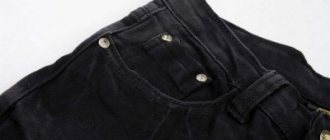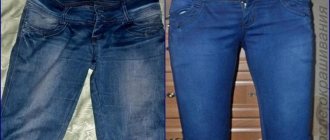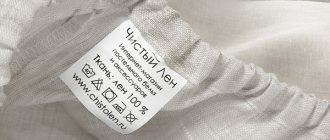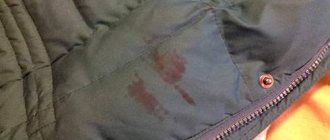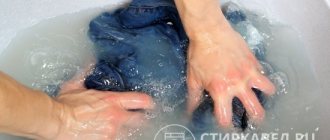Jeans are very practical to wear and always fashionable; they are equally comfortable and relevant for everyday activities and going to work. The maximum period for wearing high-quality denim clothing is up to two years. The item will last as long as possible and will not lose its aesthetic properties if you read the important rules before washing your jeans. This article provides useful recommendations to help extend the life of your favorite clothes.
Preparatory stage
Before moving directly to hand or machine washing, it is important to properly prepare your denim clothing. And the very first thing is to read the information on the label to find out what care the clothing manufacturer recommends. In particular, the temperature for washing and ironing, whether the use of bleach, machine drying, etc. is acceptable.
The pants are then checked for small items in the pockets. All contents (candy wrappers, keys, business cards, etc.) must be removed, all pockets zipped and the item turned inside out.
To preserve the color of the product as much as possible, you need to choose the right detergent. For hand washing, laundry soap is best suited. It is especially important to follow all the rules when cleaning black jeans, as they quickly lose their color saturation. When choosing a powder, it is recommended to give preference to products for colored clothes or jeans. A liquid product is best. It should not contain enzymes, phosphates and other dangerous components that can lead to loss of color.
Stain removal and whitening
To pre-treat complex stains, use cleaning products for natural fabrics: powders, gels, laundry soap and improvised products.
Soak
Soaking the product in the cleaning solution will remove most of the dirt. Dissolving stains with water and detergents will simplify the washing process.
Technology:
- Fill a container with water t 40°C.
- Prepare the solution. Dilute the detergent according to the instructions.
- Turn the product inside out.
- Immerse in water with the solution. If the thing floats, put pressure on it.
Leave the jeans for 3 hours and place them in the washing machine drum.
Soaking after purchase
A new item requires pre-processing.
For sanforized denim, soaking will remove excess substances after production, help fix the indigo dye, and reduce color loss due to friction.
Raw denim is soaked to pre-shrink the fabric.
Technology:
- Fill the bath. For raw denim, use water at 40°C, for sanforized denim - 20-30°C.
- Add 1 cup vinegar and sea salt.
- Turn the item inside out and immerse it in water. Place the weight.
Leave the denim for 1-2 hours. Rinse, remove the product, do not wring out the water.
Dry by hanging on a rope.
Washing and stain removal
Difficult stains require preliminary manual cleaning. For washing, use a soft brush, sponge, cotton pads, paper towels.
Washing algorithm with preliminary stain removal:
- Study the label.
- Choose a detergent.
- Review dosage information.
- Select a washing mode.
- Brush off the dust and pre-treat the stain by hand.
- Wash it.
Grease and oil stains
Sprinkle a fresh greasy stain with tooth powder, salt or starch and leave for 10 minutes. Carefully remove the powder with a paper towel.
On old stains, use dishwashing detergent. Unlike other stains, wash at no higher than 30°C. This will prevent the fixation of fat and oil.
Coffee, food
Prepare an emulsion to remove traces of coffee drinks: 2-3 drops of alcohol, a little warm water, egg yolk. Apply the mixture to the stain for 10 minutes, rinse with a sponge.
Remove food stains with sparkling water and salt (250 ml/10 g). Apply the solution by rubbing in with a clean cotton pad. You can treat with household laundry detergent, stain remover, or laundry soap.
Wine stains
Blot the fresh stain with a dry white cloth and remove excess liquid.
Turn the jeans inside out and rinse the stain with plenty of cold water. Apply detergent to the front side. Leave for 5-10 minutes, wash.
Paint stains
Wet water-based paint with warm water and dishwashing detergent. Oily - solvent, medical alcohol or nail polish remover.
Leave the soaked stain for 20-30 minutes and wash the item in the machine.
Stains from grass, leaves
First, let the stain dry, then scrape off the dirt. Once the dirt has been removed, apply a household cleaner or a thick layer of laundry soap shavings. Rub in gently.
After 30-40 minutes. Wash at a temperature acceptable for the product.
Recommendations:
- When using a stain remover, apply the solution pointwise so as not to damage the fabric around it. The exposure time is indicated on the packaging.
- Clean light-colored jeans with hydrogen peroxide. Spread the product liberally onto the stain and leave for 20 minutes.
If a stain from street dirt has formed on the steam, you cannot immediately wipe it off with water. An unsightly lightened stain will appear on the fabric.
Wait until the dirt dries, carefully, without unnecessary effort, wipe it off with a brush. Turn the product inside out, wash it with warm water without detergents, and put it in the wash.
Blood stains
Blood stains are afraid of cold water.
Stain removal technology:
- Fresh contamination. Blot the area with a cloth and soak for 20-30 minutes. place in an automatic washing machine.
- Obsolete. Clean the stain with dishwashing gel, salt, soda, or use a solution of cold water and detergent. Soak for 10-15 minutes. Remove from water, blot as much blood as possible and wash.
How to wash by hand?
We have already mentioned that the ideal product for hand washing jeans is laundry soap. You should take warm water into the bath and dilute a small amount of soap in it to obtain a slightly white, transparent solution. Then the pants need to be soaked for 30 minutes.
Advice! When soaked in a powder solution, buttons and jewelry often lose their shine, become dull, or become stained.
At this stage it is important:
- do not use temperatures above 40 degrees;
- do not pour powder directly onto the product;
- keep jeans in water for more than an hour;
- Do not use bleach (it can cause the item to fade).
After soaking, using a clothes brush and laundry soap, you need to get rid of any remaining dirt. The soap is applied to the brush, and then the tool is moved along the direction of the threads. This method will make it easier to get rid of contaminants. All movements must be careful. The pants should be treated on both sides and then rinsed in the shower. After this, the product should be shaken, giving it the desired shape, and hung for further drying.
Advice! It will be easier to maintain the shape of your jeans if you let the product dry on its own after washing. You should not twist the clothes with your hands; just hang the item over the bathtub and wait until the water drains from the legs.
Hand wash black jeans
There is often advice to wash jeans by hand, and not in a washing machine. This way the jeans retain their shape better after washing. Black jeans with rhinestones, lace inserts, embroidery, and a large number of decorative elements should only be washed by hand. Before hand washing your black jeans, you should soak them briefly in warm, hand-friendly water. You can add regular laundry soap and vinegar to the water. Vinegar helps preserve color. It is better to soak without washing powder. Jeans should not be soaked for more than two hours.
Black jeans should also be washed in warm, but not hot, water. Can be washed with hand wash detergent without bleach.
After washing, jeans should be rinsed very well several times so that there are no stains left on them from the washing powder.
Checking if your jeans are fading
Unfortunately, it is not uncommon for jeans to get washed out within the first few washes. This nuance must be taken into account. It is advisable to soak and clean jeans separately or with items that are closest in color and nature of the fabric.
It's worse when jeans stain your skin. This is unpleasant, in addition, sometimes it causes irritation of the epidermis. Therefore, before wearing for the first time, you need to wash your jeans. This especially applies to cheap jeans. This procedure will protect the skin from exposure to paint, as well as dust that may have accumulated or remained in the canvas from production. Checking whether jeans are fading is not difficult. It is necessary to wet the match and pass it over the dry material. If the base becomes stained, it means the item is shedding.
Should you wash black jeans often?
First of all, it is not recommended to wash jeans too often. If jeans are not washed too often, they are more likely to retain their original color and shape for a long time. In the periods between washes, jeans take on their body shape. For this quality they are loved all over the world. And also because they can be forgiven for not being too clean and unironed. But the time comes when you have to wash your jeans. And this must be done carefully and carefully.
You can wash black jeans by hand or in a washing machine. It is important not to wash them at too high a temperature and not to use aggressive detergents.
Machine washable
When washing by hand is not possible, a machine will come to the rescue. You can safely get rid of dirt using the “hand wash” or “delicate” mode. Some new brands have a denim feature.
After preparation, the turned-out pants should be placed in a drum. As with hand washing, it is advisable to wash jeans separately from other items. Pre-soaking with laundry soap or pre-wash mode will improve the result. However, the latter should be used sparingly, only when the item is heavily soiled.
It is better to choose a liquid detergent for washing jeans in an automatic machine that does not contain aggressive components that can lead to color loss. This gel penetrates better into the fabric structure, between tightly woven fibers, and is washed out more easily than powder.
The optimal temperature is 40 degrees. Cold water is worse at removing dirt, hot water damages the color and structure of cotton threads, so jeans shrink.
Advice! Denim items will not fade and will retain the brightness of the shade if you use vinegar when washing in an automatic machine. It should be poured into the conditioner compartment. If there is a measuring container for loading into the drum, that's even better. Pour vinegar into it and let it wash along with your jeans.
To protect the texture of the fabric, as well as buttons and decor, it is recommended to wash jeans in a special mesh bag or pillowcase. Another option is to wash with other dark cotton items, which will reduce the friction of the jeans against the walls of the drum.
You should squeeze at medium speed to avoid shrinkage and strong jams. Then immediately hang it up.
Useful tips
Little tricks will help enhance the effectiveness of the cleansing procedure:
- If there is no washing powder or gel in the house, you should not postpone the procedure. Grated laundry soap is great for removing various types of dirt, both manually and by machine.
- It is not advisable to twist and wring out the product; it is better to let the water drain on its own.
- It is necessary to dry away from heating devices in the fresh air.
- It must be hung from the belt.
- It is preferable to wash jeans by hand; machine cleaning can cause damage to the product.
How often to wash jeans is up to everyone to decide for themselves, but you should understand that too frequent use of synthetic products and water can wash out even the most durable colors.
It’s clear how to wash jeans without ruining them. Put into practice the tips and recommendations, then your clothes will be in perfect order for a long time.
Many housewives are annoyed after washing when they see that their colored linen has faded. How to wash correctly, Items made of viscose look very beautiful and bright, but due to improper care they become very fast, Natural fabrics are expensive, but cause certain difficulties when washing. To remove contaminants you will need, Properly washing and drying a down jacket is a whole science, because due to poorly selected
How to dry
After blotting with a towel to remove excess moisture, or squeezing at medium speed in an automatic machine, you need to hang the jeans to dry. The use of a drying drum is also acceptable.
It is important to follow a number of rules in order to maintain the shape and color of the product, as well as to make ironing easier:
- It is prohibited to use the “hot drying” mode;
- Drying with an iron is extremely harmful to fabric;
- You shouldn’t throw your pants over a rope; it’s best to use a hanger-clip for trousers or attach your jeans to the rope with clothespins;
- It is highly not recommended to dry denim clothes in direct sunlight or near a heating device;
- Before wearing, the product must dry completely, otherwise the trouser legs will stretch at the knees, and the defect will be extremely difficult to correct.
Advice! To prevent pocket marks from appearing on the fabric, use fabric pads. If you insert them into the middle of the pockets, it will be easier to avoid harmful effects on the fabric.
How to dry and iron black jeans after washing
Jeans should be dried after washing by hanging them from the belt. Before drying, lay the jeans out on a flat surface and straighten them out. Labels and other leather elements are lubricated with glycerin before drying so that they do not become dull or cracked.
You cannot dry black jeans on radiators, heaters, or in the open sun.
Jeans should be ironed from the wrong side. If the jeans were dried flat, you don’t have to iron them.
So, if you wash black jeans correctly, they will retain their color and attractive appearance for a long time.
Note to housewives
When dried properly, jeans straighten out under their own weight and do not require ironing. Denim is a very dense fabric that is wrinkle resistant. If you still need to iron, do it while the jeans are slightly damp - this will make it easier for the fabric to straighten out. Ironing from the inside out is preferred.
Black jeans will lose their color less if they are first left in water and vinegar. The acid will set the dye in the middle of the fibers. Dark blue and black jeans will fade less if you subsequently wash them in slightly salted or acidified water.
It is better to wash denim clothes with embroidery and rhinestones by hand. When cleaning by machine, be sure to not only turn your pants inside out, but also place them in a special bag (pillowcase). In this case, the most gentle mode is set, for example, “Wool”: it is better to hang very damp, wet jeans than to lose all the decor, and even clog the filters of the machine with it.
It is not recommended to dry clean jeans. Chemicals negatively affect the fabric, as a result of which the item quickly loses its appearance.
By following the above recommendations, it will not be difficult to clean the dirt from your favorite jeans. Good denim can withstand both hand and machine washing. For cheaper samples, you just need to choose a more gentle mode. It is recommended to pay attention to the selection of detergents and not to overdo the spin cycle, and your clothes will look like they came from a store for a long time.
Types of denim fabrics
The fabric is distinguished by its composition, technology of weaving threads, and method of dyeing. The type of denim fabric determines the quality and service life of the finished product.
Classification:
- Denim. Classic durable smooth fabric. Formed by weaving two-color fibers based on extra long cotton. The warp threads are blue, the weft threads are bleached and undyed. The reverse side is much lighter than the front side. Indigo dye does not penetrate into the fibers and is deposited on the surface. The material is not picky to care for, but during washing the dye is gradually washed out and the jeans lighten.
- Broken twill, twill. Fabric with a characteristic right- and left-hand twill weave. Reminiscent of a herringbone pattern on the diagonal of the canvas. Varies in thickness and thread density. Broken lines form a dense texture that will last for many years. Original Wrangler models are constructed from twill.
- Stretch, lycra. Cotton fabric with synthetic fibers. More often, manufacturers use elastane, less often - Chinese nettle ramie. The denim fabric stretches and shapes your figure. The material is difficult to wash. Improper care leads to shrinkage and loss of elastic properties.
- Gin. Plain blue cotton fabric. Made from cheap cotton. Major global brands use gin in the most budget models. Requires delicate handling.
- Chambry. Lightweight, thin melange cotton fabric. The threads are intertwined without displacement, at right angles. The basis of laconic, easy-to-wear items: shirts, tunics, dresses.
- Eikru (ecru). Untreated cotton, linen material made from undyed yarn. The color depends on the type, quality of the fiber, and manufacturing technology.
It is customary to distinguish between sanforized and raw denim. Processing using sanforization technology reduces shrinkage and shedding due to maximum leaching of the dye.
Rigid denim without factory processing during the first treatment intensively loses indigo and shrinks in size.
Preventing color loss
You can return the color to jeans, but it is much easier to prevent its loss by properly caring for your things. To do this, you need to remember a couple of simple nuances:
- Wash your clothes in the cycle indicated on the jeans tag.
- Use special gels and powders for black linen.
- After washing, rinse the jeans in cold water with the addition of baking soda or table salt.
- Enzyme gels and powders can be used to remove stains.
How to restore color to black clothes at home
To restore the rich shade of black products without much money or time, you can use simple folk recipes. There are several proven methods that will quickly put a dark thing in order. In the process, available ingredients will be used.
Tobacco
Dry tobacco mixture is used not only for smoking, but also for restoring color to faded dark things. Surprisingly, ordinary cigarette tobacco gives black products a new life. The prepared solution is suitable for any material, even wool, velvet, and knitwear. The main condition is correct processing depending on the size of the product.
Recipe one:
- Take a liter of water and pour it into a metal container.
- Boil water, add 15 grams of tobacco.
- Leave the mixture in a water bath for 30 minutes.
- Cool the solution, strain, let the item sit for half an hour, rinse and dry.
You should end up with slightly brownish water. The method is perfect for T-shirts, scarves, socks and other cotton items. If the product is large in size, then it is treated point by point with a solution already prepared according to the instructions above.
Method:
- Prepare the same brown water;
- We take a clean, dry product and lay it out on the table;
- Then moisten the desired areas with a sponge and wait until dry.
This method will help if your black jeans, dress, coat, or robe have faded. It is worth remembering that not everyone likes the smell of tobacco, so after processing the large product is dried in the open air, and the small product is washed with powder for dark material.
Coffee to the rescue
Coffee is ideal for returning the rich color to faded items. It flavors the product; after treatment, your favorite trousers or dress will emit a subtle, pleasant coffee aroma. So, how to return the black color to faded things using coffee:
- Take a liter of hot water.
- Add 50 grams of instant coffee.
- Mix everything and let the drink cool.
- Next, process the product and dry it.
To achieve the desired effect, clothes are pre-washed and allowed to dry. The item can be soaked in the resulting solution for half an hour, then dried in the fresh air. Coffee is also often replaced with black tea. The cooking recipe is the same.
Vinegar
The vinegar solution retains the shade and gives the product its original rich black color. To prepare it, take a spoonful of vinegar and a liter of water. Then leave the item for half an hour, rinse, and dry in the fresh air. It is important not to overexpose the fabric for more than 30 minutes, otherwise the item of clothing will settle. The rule applies not only to vinegar soaking, but also to other methods.
Soda and salt
Two ingredients, using filtered water, adds blackness and shine to faded or faded items. To prepare, take a pinch of salt and a tablespoon of soda, add water, and soak the item for half an hour. Next, it is rinsed and dried. You can pour a little washing gel into the solution. Before soaking, clothes are washed and dried. The mixture is also boiled over low heat (30 minutes).
Other home methods
If your black jeans have faded and you don't know how to get the color back, try re-washing them with old dark clothes. Place the products for 15 minutes in warm water without powder, then wash in a machine. To improve the result, the wash is stopped in the middle of the cycle so that the items are properly colored. It is better to use old wool sweaters, which fade even after numerous washes. The clothes are then removed and rinsed in a vinegar solution that sets the dye.
You can also rinse or wash your wardrobe item in water with black mascara added. Some laundry detergents labeled “for black” do a good job of restoring color. Add more product than usual. In severe cases, repeated washings in this manner will be necessary. Ammonia has proven itself well. The solution consists of a liter of water and 20 ml of medicine, in which the laundry is soaked for 15 minutes.
How to determine whether a new thing will be painted
There is always a chance that the jeans you like will be dyed. This unpleasant property is inherent in both budget items from the market and expensive ones from a fashion boutique.
If jeans are purchased online, you can find out how susceptible they are to shedding only after soaking. The water has turned blue, which means the paint is leaking.
If trousers are purchased at a regular retail outlet, color fastness is assessed upon first inspection. You can do this in several ways:
- Read the label. If the item is of good quality, the manufacturer warns about the possibility of staining the body, clothing and light-colored furniture at the beginning of wear.
- Gently rub your palm across the fabric. If there are blue marks left, it is better to refuse the purchase. These trousers will never fail to shine.
- Rub the denim with a match, thread, napkin or cotton wool soaked in water. If the tester is stained, it means the jeans are fading. In this case, it is not necessary to return them to the seller. In most cases, a few simple steps will successfully resolve the problem.
You should not put on jeans immediately after purchasing. Even if they did not leave stains on the body and clothes during fitting, this will happen several hours after wearing. At the same time, everything that came into contact with the new thing, including your bag and shoes, will turn blue.
